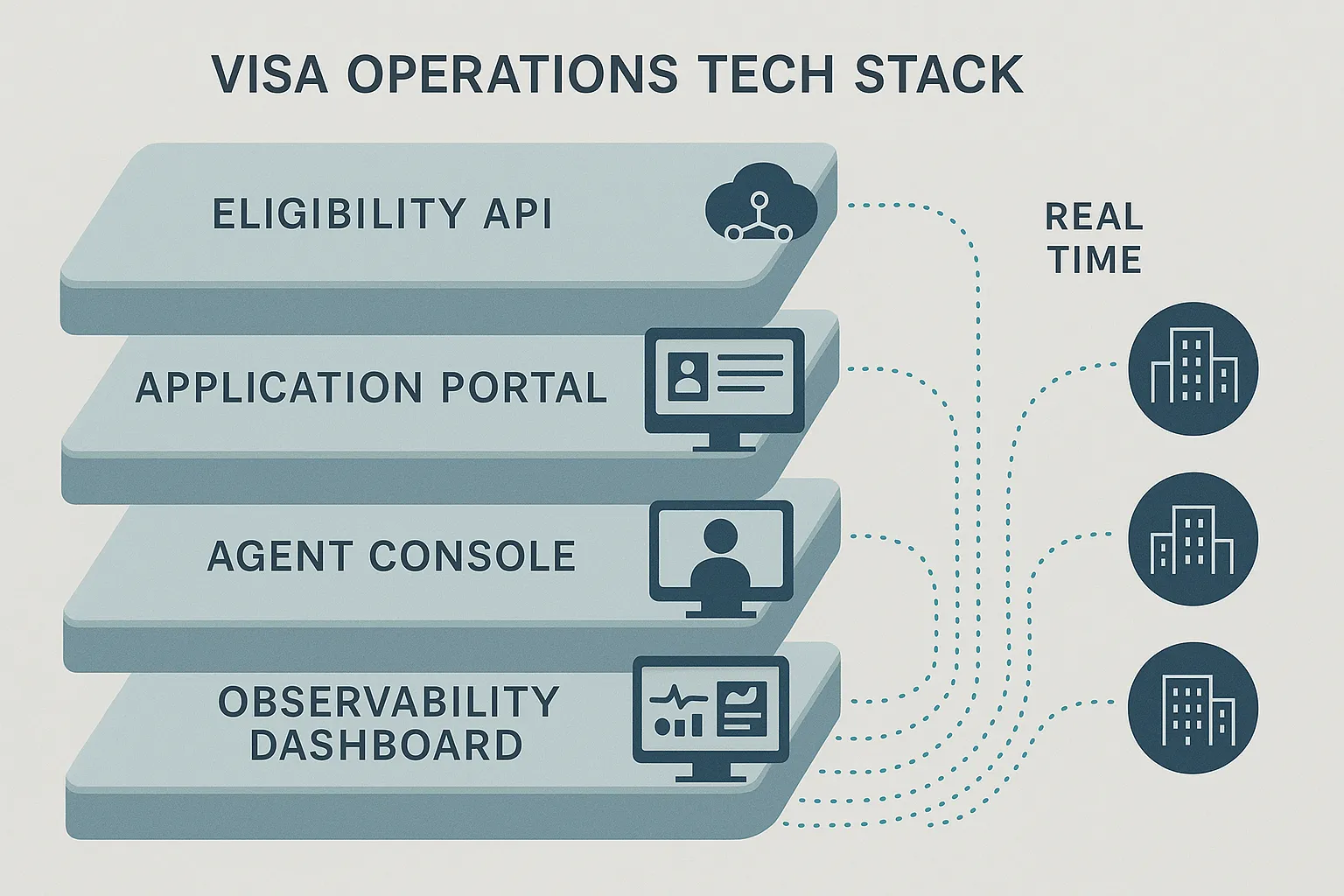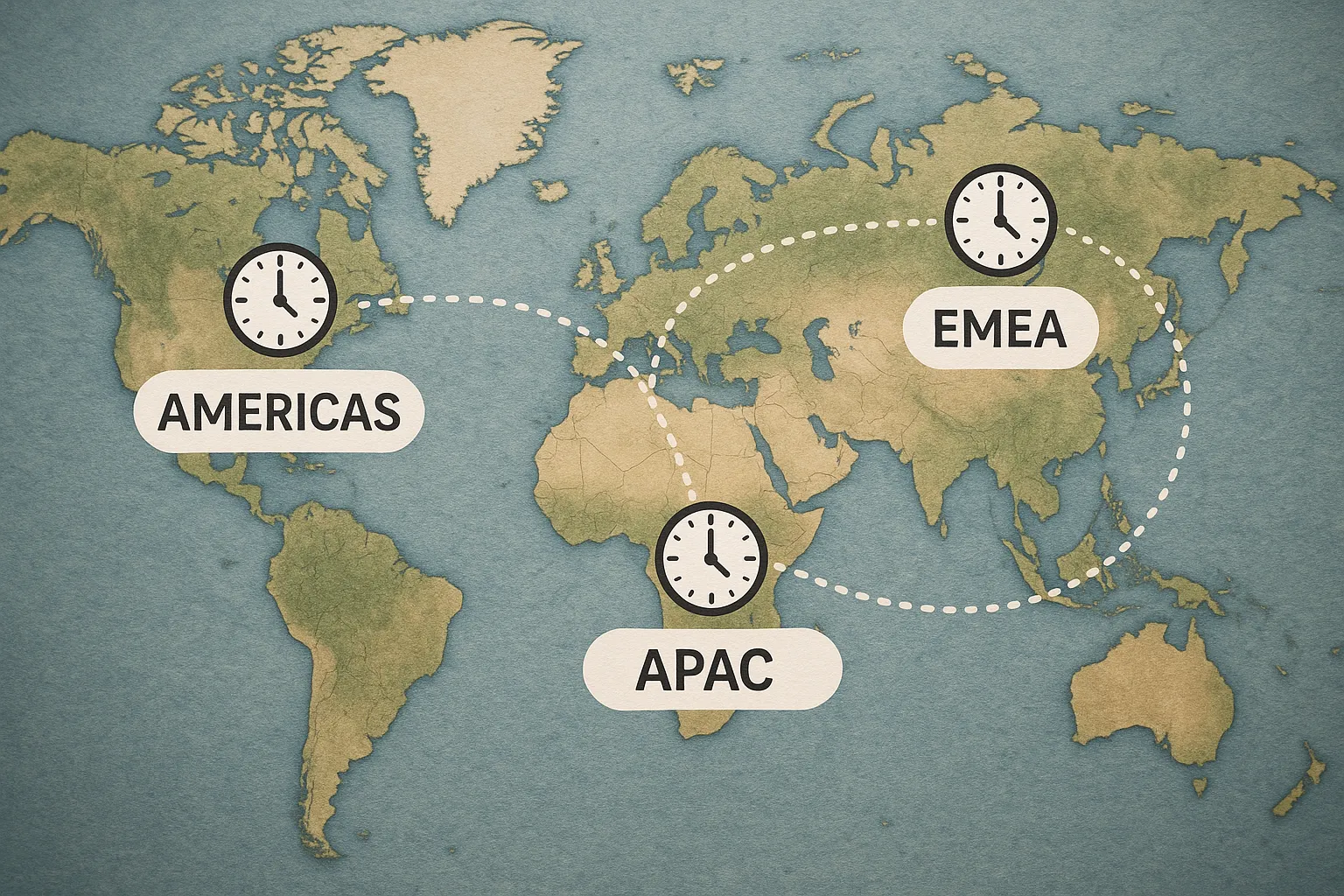Building a 24/7 Visa Operations Desk: Staffing, SLAs, and Tooling

Running a visa desk during business hours is challenging enough. Keeping it operational every hour of every day – across peak booking surges, public-holiday departures, and midnight denial appeals – takes a very different playbook. In 2025, leading airlines, OTAs, TMCs, and cruise lines are building 24/7 visa operations desks to protect revenue, lift customer satisfaction, and stay compliant with tightening border regulations such as ETIAS and the UK ETA.
This guide breaks down the three pillars of a round-the-clock program: people, performance, and platforms. You will learn how to design cost-efficient staffing patterns, negotiate service-level agreements (SLAs) that really matter, and choose tooling that prevents emergencies instead of merely reacting to them.
Why 24/7 Coverage Matters
- Denied-boarding fines are rising. IATA data shows carriers paid an estimated US $9.2 billion in regulatory penalties and irrecuperable costs linked to documentation errors in 2024.
- Booking windows are shrinking. SimpleVisa’s analytics (9.4 million bookings, Jan 2024–Jun 2025) reveal that 34 percent of eVisa applications now occur within 72 hours of departure – half of them outside local office hours.
- Global customer support expectations have changed. Travelers expect live help in their time zone and language; corporate buyers embed 24/7 assistance in RFP requirements.
Failing to meet those expectations means lost revenue, preventable chargebacks, and reputational damage. A dedicated operations desk can slash incidents, lift ancillary attach rates, and feed real-time policy feedback into your product roadmap.
1. Staffing Models That Scale
| Model | Coverage Logic | Typical Headcount | Pros | Cons |
|---|---|---|---|---|
| Follow-the-sun (3 hubs) | Americas, EMEA, APAC each own 8-hour block | 3–5 FTE per hub | Local language support, minimal night work | Requires global offices or BPO partners |
| Split-shift (single hub) | Two 12-hour shifts with a 2-hour overlap | 7–10 FTE | Simpler knowledge transfer | Higher night-shift premiums, fatigue risk |
| Hybrid | Core team in HQ + after-hours BPO | 4–6 FTE internal, 6–8 FTE external | Cost-effective, rapid scaling | Needs strong playbooks and QA |
| “Zero-contact” automation first | 1–2 FTE Tier-2 specialists + automation rules | 3–4 FTE | Lowest cost per case, handles spikes automatically | Up-front investment in rule engine and APIs |
Key hiring ratios from high-performing desks:
- 1 Team Lead per 6 agents to coach, approve escalations, and manage scheduling.
- 1 Policy Specialist per 10 agents to update visa rulebooks and liaise with government portals.
- 1 Integration Engineer per desk (often part-time) to maintain APIs, webhooks, and dashboards.
Skill Set Checklist
- Multilingual (at least English + one of: Spanish, French, Mandarin, Arabic)
- Familiarity with XML/JSON visa schemas and airline DCS fields
- Proven experience with IATA Timatic or comparable data sources
- Comfort using workflow or RPA tools (Zapier, UiPath, or SimpleVisa’s no-code rules engine)
2. Defining SLAs That Drive Outcomes
Many teams default to generic response times. Instead, link SLAs to tangible business impacts.
| SLA Metric | Recommended Target | Business Impact |
|---|---|---|
| First response time on “visa error at check-in” tickets | < 5 minutes | Avoids passenger off-loads and compensation payouts |
| Application review turnaround (standard) | < 60 minutes | Keeps conversion high in booking flow |
| Application review turnaround (expedited) | < 15 minutes | Monetisable premium service; defends last-minute bookings |
| Approval rate | > 98% | Directly tied to ancillary revenue and NPS |
| Data accuracy (submitted vs. passport) | > 99.5% | Reduces government rejections and chargebacks |
| API uptime (partner facing) | 99.95% monthly | Prevents booking-flow errors and cart abandonments |
Best practice is to publish two SLA tiers: Core (included for all partners) and Premium (paid upgrade). Airlines often bundle Premium SLAs with priority escalation lanes and dedicated account managers to justify higher rev-share splits.
Setting Realistic Targets
- Analyse historical ticket volume by hour and visa type.
- Factor in seasonal surges (July/August, December) and new regulatory deadlines (e.g., ETIAS Q3 2025 launch).
- Run queuing simulations (little’s law) to validate headcount.
SimpleVisa customers can pull webhook events straight into a BI tool to model wait times and project SLA breach risk – no data exports needed.
3. Tooling: From Reactive Support to Preventive Ops
A 24/7 desk without the right software quickly becomes an email treadmill. Modern teams layer four platform categories:
- Eligibility & Rules Engine – Real-time API that returns personalized visa requirements and auto-fills forms (e.g., SimpleVisa Eligibility API). Prevents incorrect applications before they hit the desk.
- Application Workflow System – White-label portals or embedded widgets where travelers submit documents, pay fees, and track status. Must support SSO, 3-D Secure, and localized strings.
- Agent Console – Unified view of all applications with lifecycle states, SLA timers, and AI-powered validation (OCR, MRZ parsing, facial liveness checks). SimpleVisa’s console flags high-risk applications for manual review and lets Tier-1 approve low-risk cases in bulk.
- Observability & Alerting – Dashboards and on-call alert rules (PagerDuty, Slack, Opsgenie) that monitor API latency, rejection spikes, and payment-gateway errors.

Build vs. Buy Decision Table
| Requirement | Build In-House | Buy (SimpleVisa) |
|---|---|---|
| Development speed | 6–12 months | 4–6 weeks (API) / 2 days (widget) |
| Government portal maintenance | Internal team must update daily | Handled by SimpleVisa’s policy specialists |
| Security audits (ISO 27001, SOC 2) | Costly and time-consuming | Pre-certified platform |
| Cost per application | Higher at low volumes | Scales with usage; no fixed CAPEX |
| Road-map agility | Limited by engineering bandwidth | New destinations and ETIAS rules shipped automatically |
For most mid-market OTAs, a buy-plus-customize approach wins: integrate the Eligibility API to pre-screen passengers, embed the hosted application widget post-booking, and route edge cases to an internal or BPO desk.
4. Operating Procedures That Keep You Audit-Ready
- Standard Operating Procedures (SOPs) – Version-controlled playbooks covering application vetting, escalation tiers, and data-privacy protocols (GDPR, PCI-DSS).
- Shift Hand-Off Rituals – 15-minute overlap with a structured template: pending high-priority tickets, system incidents, government portal outages.
- Quality Assurance (QA) Sampling – Randomly audit 2–5 percent of daily approvals; use double-blind reviews to avoid bias.
- Continuous Training – Follow the seven-day blueprint in our post “How to Train Customer Support Teams on eVisa Rules in One Week” for rapid onboarding. Schedule refresher micro-modules ahead of new policy rollouts.
- Incident Post-Mortems – For every SLA breach or denied boarding, publish blameless RCA within 48 hours and update safeguards.
5. Cost Model and ROI Snapshot
Below is a simplified annual budget for a hybrid 24/7 desk processing 120 000 visa applications per year (approx. 330 per day).
| Cost Item | Annual Cost (USD) |
|---|---|
| Core team salaries (6 FTE, avg $48 k) | $288 000 |
| BPO after-hours coverage (per-ticket $1.30) | $156 000 |
| SimpleVisa API & platform fees (tiered) | $1.10 per application → $132 000 |
| SaaS tools (ticketing, observability) | $24 000 |
| Training & QA | $18 000 |
| Total OPEX | $618 000 |
Revenue side (conservative assumptions):
- Average visa service margin: $15
- Attach rate: 7 percent of 2 million annual bookings → 140 000 applications
- Gross ancillary revenue: $2.1 million
Result: $1.48 million net contribution and a 3.4× ROI, not counting avoided denial fines and loyalty-score gains.
6. Implementation Timeline (90 Days)
| Week | Milestone |
|---|---|
| 1–2 | Sign commercial agreement, pull historic booking data, define SLAs |
| 3–4 | Generate sandbox API keys, embed Eligibility API in dev checkout, build custom SLA dashboards |
| 5–6 | Recruit or assign pilot agents, complete seven-day training module, finalize SOP v1.0 |
| 7–8 | Launch internal beta (10 percent traffic), monitor error rates, run load tests |
| 9–10 | Expand to 50 percent traffic, begin follow-the-sun coverage using BPO partner |
| 11–12 | Full rollout, activate Premium SLA upsell, schedule first QA audit and business-review meeting |

Next Steps
Building a 24/7 visa operations desk no longer requires a blank cheque or a 40-person night team. With the right mix of automation, strategically located talent, and outcome-driven SLAs, you can protect passengers, unlock high-margin ancillary revenue, and sleep easier when the next policy change goes live at 3 a.m.
Ready to design or optimise your own program? Explore our technical deep dives – such as “Travel Tech Stack 2025: Where a Visa Management Platform Fits In” and “Step-by-Step Guide to Testing Sandbox eVisa Transactions” – or book a live demo to see how SimpleVisa’s API and white-label toolkit can power a compliant, always-on operation in weeks, not months.